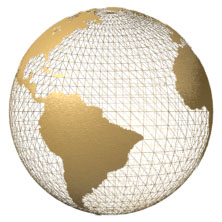| GigaPackets |
|
|
Fixed Wireless Access

Managed SDN & SD-WAN
Dark Fiber - Wavelength Service
How Carrier Ethernet Interconnects LANs
Network management made easier by a common Ethernet protocol for LAN, MAN, and WAN.By: John Shepler
Ethernet, pretty much the default standard for Local Area Networks, is now being touted as the coming replacement for metro and wide area services such as ATM, Frame Relay, SONET and even TDM (Time Division Multiplexing) networks in general. That's pretty much out with telecommunications as we've known it and in with something new. Or at least something new to Wide Area Networking.
Where Carrier Ethernet Makes Sense
Why Carrier Ethernet? It's actually quite logical, even Darwinian, that Ethernet should swallow up competing metropolitan and long haul digital transmission standards. That's exactly what happened over the last 30 years as Ethernet evolved from a research paper to the preeminent local area networking standard. Now that Ethernet is the best understood and most widely supported network protocol, it only makes sense to join local area networks to metropolitan area networks to wide area networks, perhaps worldwide networks. Why not have one ubiquitous standard used by all?The Legacy TDM Standard
In fact, in the telephony world there has been just such a ubiquitous standard for digital communications. It's TDM or Time Division Multiplexing. A PBX system plugs into a T1 PRI line. Multiple T1s are multiplexed to form T3 lines or DS3 services that are further multiplexed into SONET fiber optic carriers. The complete digital signal hierarchy is designed around the lowest common denominator, the DS0 or 64 Kbps channel. Why 64 Kbps? That's the channel size to accommodate one digitized telephone call.The LAN / WAN Disconnect
The only problem is that computers, especially PC based computing, is not designed around legacy analog telephone services. Local area networking is based on Ethernet, which is based on data packets rather than synchronized time slots. It is at the local/wide area interface that the clash of cultures occurs. Right now that largely means protocol conversions so that 10/100 base T and GigE networks can send data over T1, DS3, and SONET networks. ATM cells and Frame Relay frames can be converted to and from TDM format. Even long haul Internet connections often employ TDM based optical carrier services.These accommodations certainly do work, but it seems more efficient to have a single network protocol from end to end. As telephony starts to convert from TDM based telephone switching systems to VoIP equipment, it makes sense to migrate toward Ethernet as the future standard. The challenge is to engineer wide area Ethernet networks that offer the same reliability and protections designed into TDM networks.
Ethernet Goes Carrier Grade
That's where Carrier Ethernet Services come into play. Carrier Ethernet is a fairly new development being standardized by the Metro Ethernet Forum. The MEF has defined five attributes that are essential for carrier grade Ethernet service. They are standardized services, scalability, reliability, quality of service and service management.Standardization of services must include provisions to carry legacy TDM traffic that is highly time sensitive. In effect, flipping the current situation where TDM circuits transport Ethernet packets from one LAN to another by fitting them into available TDM channels. Instead, carefully controlled packet networks will carry TDM data without the latency and packet loss that can occur on "best effort" networks.
Carrier Ethernet is Available Now
Carrier Ethernet Services are already available in major metropolitan areas from competitive carriers such as XO Communications. You can order 10 Mbps Ethernet, 100 Mbps Fast Ethernet or Gigabit Ethernet connections to match your current network bandwidth. Standard 10BaseT, 100BaseTX, and 1000BaseSX/LX interfaces are supported at the WAN edges. It's almost a plug-and-play situation allowing you to treat your interconnected LANs as one large network, even when spread across the country.Find Fiber Optic Bandwidth Services Now
Optical carrier services, including Fast Ethernet & Gigabit Ethernet over Fiber, SONET, Wavelengths, Dark Fiber and other high speed low latency digital line services, including Managed SDN Software Defined Networking and SD-WAN, for commercial business and organizational applications. Find out what network services and pricing are available now for your commercial business building anywhere in the U.S. Simply call 1-888-848-8749 or use this handy form...
Fiber Bandwidth & Cloud Services Inquiry
Thank you for your interest. A technology services expert will be in touch soon. Please provide accurate phone & email contact information or call toll free for support anytime at 1-888-848-8749. All information you provide will be used only to support your inquiry.

|